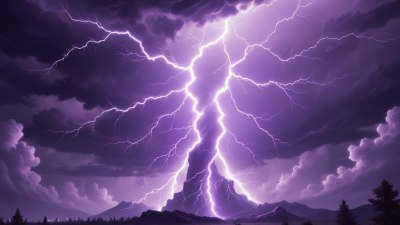Why Are Some Lightning Strikes Stronger
Explore why some lightning strikes are more powerful than others and the science behind it.

This image was created with the assistance of Freepik
Lightning is a spectacular natural phenomenon that captivates many with its beauty and power. While it is often viewed as merely a flash of light and a loud clap of thunder, the reality is that lightning is a complex and dynamic process. Understanding why some lightning strikes are stronger than others requires insight into the atmospheric conditions, electrical charges, and the nature of precipitation that lead to these magnificent displays of nature's power.
The Basics of Lightning Formation
Lightning occurs when there is a difference in charge between two regions in the atmosphere. This charge separation usually takes place within a storm cloud. Typically, the top of the cloud becomes positively charged while the bottom becomes negatively charged. When the difference in charges becomes great enough, it may result in a discharge of electricity, or lightning. The strength of a lightning strike can vary substantially based on several factors, including humidity, temperature, and the presence of ice or hail within the storm system.
Types of Lightning Strikes
There are several types of lightning strikes, each with different characteristics and strengths. The most common types include intracloud lightning, cloud-to-ground lightning, and ground-to-cloud lightning. Intracloud lightning occurs within the cloud itself and is often weaker compared to cloud-to-ground. Cloud-to-ground lightning is the most dangerous type and tends to be the strongest due to the high voltage involved when the electrical discharge travels from the cloud to the Earth. Ground-to-cloud lightning, on the other hand, is less common and occurs when an electrical discharge travels from a tall structure to a cloud. These categorizations help define why some lighting strikes exhibit more power and intensity.
Factors Influencing Lightning Strength
Several critical factors influence the strength of lightning strikes. The first is the amount of charge present in the storm cloud. The more separated or concentrated the electrical charges are, the stronger the lightning strike will be when they finally connect. Temperature also plays a vital role; warmer air can carry more moisture, leading to stronger thunderstorms and, consequently, more potent lightning. Additionally, the presence of ice crystals, which tend to create very strong electric fields, can also enhance lightning strength significantly, particularly in severe thunderstorms where hail forms.
Charge Density and Lightning Intensity
The density of the charge within a storm system significantly impacts the intensity of lightning. Strong thunderstorms often experience rapid charge buildup due to strong updrafts. When rain cascades down through the storm, it collides with particles, creating a mechanism through which electrical charges can separate efficiently. This process leads to higher charge densities and stronger lightning. Conversely, weak storms with less vigorous updrafts tend to produce weaker lightning strikes, as they struggle to generate sufficient charge separation.
Understanding Lightning Leaders
When a lightning strike occurs, it does not form as a single bolt but rather undergoes a series of steps involving leaders. The initial leader, known as a stepped leader, propagates downward from the cloud in discrete steps. This leader creates a conductive path that, upon reaching the ground, allows the return stroke to travel back up. The strength of the returned stroke can be influenced by several factors, including the length and branching structure of the leaders, which ultimately affects the energy released in the final discharge. A well-structured and extended leader can lead to a much stronger lightning strike.
Geographical Variations
The geographical location also plays a crucial role in the strength of lightning strikes. Thunderstorms that develop over mountains, for instance, often produce more powerful lightning due to orographic lifting, which enhances moisture availability and updraft strengths. Regions near the equator or tropical areas tend to experience more frequent thunderstorms due to the climate's heightened warmth and moisture, leading to more powerful lightning strikes. Conversely, cooler regions may have less intense thunderstorms, resulting in weaker lightning exhibits.
The Role of Climate Change
As climate change continues to influence weather patterns globally, its effects on lightning strikes have also come under scrutiny. Research indicates that warming temperatures may lead to an increase in the frequency and intensity of thunderstorms, subsequently increasing the occurrence of strong lightning strikes. The enhanced water vapor in the atmosphere can lead to stronger storms, which may result in more electricity generation within clouds. As storm conditions become more potent, the potential for stronger and more dangerous lightning strikes increases.
Safety Measures Against Lightning
Due to the power and unpredictability of lightning, it is essential to take safety measures during thunderstorms to avoid the risks associated with lightning strikes. It is always advisable to seek shelter indoors during any thunderstorm. Staying away from windows, doors, and electrical devices can minimize the risk of injury. Furthermore, avoiding open spaces and tall objects, such as trees, can reduce the chance of being struck. Education and awareness regarding the dangers of lightning can help keep individuals safe during severe weather events.
In conclusion, the reason why some lightning strikes are stronger than others can be attributed to several interrelated factors, including charge density, geographical variations, temperature, and the presence of moisture in the atmosphere. By understanding these mechanics, we can foster a greater appreciation for the complexity and power of lightning. As research continues to evolve, we may gain insights that enhance our preparedness for storms and improve our understanding of this awe-inspiring natural phenomenon.











